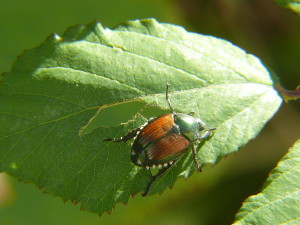
Japanese Beetles: Invasive Pests Strike Again!
Our arborists warn that in the next few weeks you may start seeing a decline in your Roses, Crape Myrtles, Japanese Maples, Plums or other ornamental plants from Japanese Beetles. First brought to the United States in 1916 in a shipment of iris bulbs, this invasive insect has been wreaking havoc on more than 300 plant/tree species. Because of the rainy summer last year, Japanese Beetle populations are predicted to be high in our area this summer.
Adult Japanese Beetles are most prevalent from June through August and can defoliate an entire tree in a matter of days. These beetles are skeletonizers, which means they feed on leaf tissue leaving only the veins behind and in heavy infestations the entire tree can be affected, tuning all leaves brown.
This insect does damage during two parts of its lifecycle; as larvae and as an adult beetle. Spending most of its life in the larval stage as a grub, Japanese beetles, feed on grass roots leading to lawn damage and extensive turfgrass damage. However; most homeowners only notice the damage done during this insects adult life as a beetle.
 Adult Japanese Beetles Damage Includes:
Adult Japanese Beetles Damage Includes:
- Large amounts of brown chewed leaves.
- Skeletonized leaves (only the veins of the leaf left intact)
- Leaves falling off trees
- Trees that look scorched by fire from a distance.
You may also see the actual beetles crawling and feeding on your trees and shrubs. These beetles have a dark metallic green head and metallic dark tan wings.
Without Treatment Things Will Get Worse:
If you have signs of a Japanese Beetle infestation it will get worse unless you act. These beetles leave a pheromone on the leaves they have already attacked which attracts additional Japanese Beetles to the tree or shrub. This, of course, increases the population levels on your property making the infestation worse. But Adult Japanese Beetles will also lay their eggs on your property in late summer.
This means that a new generation of Japanese Beetle grubs will be damaging your lawn from late summer to early spring. Then you will see a whole new generation of adult beetles damaging your trees and shrubs, repeating the cycle year after year until you trees succumb to their damage.
Susceptible Plants:
As mentioned above, Roses, Crape Myrtles, Japanese Maples, and Plums are all highly susceptible to Japanese Beetles. However, susceptible species also include Elm, Linden, Mountain Ash, Apple, Birch, Cherry, Crabapple, and Walnut.
We Can Help:
Although Japanese Beetles are extremely damaging we can help stop them in their tracks and prevent them from feeding on your landscape. We offer programs and treatments to protect your ornamental plants and trees from Japanese Beetles.
Preventive Measures: prevention is typically the best option when it comes to insect infestations. If you are planning on renovating your landscape you can plant trees and shrubs that Japanese Beetles tend not to infest. These include: Elder, arborviate, black oak, boxelder, lilac, euomymus, fir, green ash, hemlock, holly, pine, red oak, rhododendron, scarlet oak, silver maple, spruce, white ash, white ak, white poplar, and yew.
Traditional Control:
Traditional control depends on the type of tree or shrub species affected and your landscape as a whole. An arborist may recommend insecticides, soil applications, or spray treatments to control the Japanese Beetle population on your property.
DIY Japanese Beetle Traps:
You may see Japanese Beetles traps recommended online; however, these will only make your infestation worse! All these traps do is attract more hungry adult beetles to your lawn that will end up feasting on your trees and shrubs instead of the traps.
Set up a consultation with your Certified Arborist online today to make sure your landscape is protected or call 703.573.3029 to schedule an appointment.


